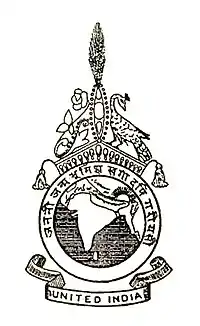Delhi conspiracy case
The Delhi Conspiracy case, also known as the Delhi-Lahore Conspiracy, refers to a conspiracy in 1912 to assassinate the then Viceroy of India, Lord Hardinge, on the occasion of transferring the capital of British India from Calcutta to New Delhi. Hatched by the Indian revolutionary underground in Bengal and Punjab and headed by Rash Behari Bose, the conspiracy culminated in the attempted assassination on 23 December 1912, when a homemade bomb was thrown into the Viceroy's howdah as the ceremonial procession was moving through the Chandni Chowk suburb of Delhi. Although injured in the attack, the Viceroy escaped with flesh wounds, but the servant behind him holding his parasol was killed. Lady Hardinge was unscathed; as was the elephant and its mahout (handler). Lord Hardinge himself was injured all over the back, legs, and head by fragments of the bomb, the flesh on his shoulders being torn in strips.[1]
| Anushilan Samiti |
|---|
 |
| Influence |
| Anushilan Samiti |
| Notable events |
| Related topics |

In the aftermath of the event, efforts were made to destroy the Bengali and Punjabi revolutionary underground, which came under intense pressure for some time. Rash Behari Bose,[2] identified as the person who threw the bomb, successfully evaded capture for nearly three years, becoming involved in the Ghadar conspiracy before it was uncovered, then fleeing to Japan in 1915.
The investigations in the aftermath of the assassination attempt led to the Delhi Conspiracy trial. The case was filed against Lala Hanumant Sahai, Basant Kumar Biswas, Bhai Balmukund, Amir Chand and Avadh Behari. On 5 October 1914 Lala Hanumant Sahai was sentenced to life imprisonment in the Andaman Islands, and the other four were sentenced to death for their roles in the conspiracy.
See also
References
- "India Truly Loyal, Says Hardinge" (PDF). New York Times. 20 May 1916.
- Indian Freedom Fighters by Vipin Chandra
Bibliography
- Gupta, Amit K (1997), Defying Death: Nationalist Revolutionism in India, 1897-1938.Social Scientist, Vol. 25, No. 9/10. (Sep. - Oct., 1997), pp. 3-27, Social Scientist, ISSN 0970-0293
- Hopkirk, Peter (1997), Like Hidden Fire: The Plot to Bring Down the British Empire., Kodansha Globe, ISBN 1-56836-127-0